Study of Human Activity Intensity from 2015 to 2020 Based on Remote Sensing in Anhui Province, China
Abstract
1. Introduction
2. Materials and Methods
2.1. Study Area
2.2. Data and Materials
2.2.1. Land Cover
2.2.2. Auxiliary Data
2.3. Methods
2.3.1. HAILS Estimation
2.3.2. Analysis Methods
3. Results
3.1. Spatial and Temporal Variations of HAILS
3.2. Slope Analysis of HAILS
3.3. HAILS Variation along the Flow-Path Distances
4. Discussion
4.1. Validation of the HAILS Index
4.2. Correlation between HAILS and Nighttime Light Data
4.3. Drivers for the Changes
5. Conclusions
Author Contributions
Funding
Data Availability Statement
Acknowledgments
Conflicts of Interest
References
- Ouyang, Z.; Zheng, H.; Xiao, Y.; Polasky, S.; Liu, J.; Xu, W.; Wang, Q.; Zhang, L.; Xiao, Y.; Rao, E.; et al. Improvements in ecosystem services from investments in natural capital. Science 2016, 352, 1455–1459. [Google Scholar] [CrossRef] [PubMed]
- Ellis, E.C.; Ramankutty, N. Putting people in the map: Anthropogenic biomes of the world. Front. Ecol. Environ. 2008, 6, 439–447. [Google Scholar] [CrossRef]
- Hu, X.; Ma, C.; Huang, P.; Guo, X. Ecological vulnerability assessment based on AHP-PSR method and analysis of its single parameter sensitivity and spatial autocorrelation for ecological protection—A case of Weifang City, China. Ecol. Indic. 2021, 125, 107464. [Google Scholar] [CrossRef]
- Xiong, Y.; Xu, W.; Lu, N.; Huang, S.; Wu, C.; Wang, L.; Dai, F.; Kou, W. Assessment of spatial–temporal changes of ecological environment quality based on RSEI and GEE: A case study in Erhai Lake Basin, Yunnan province, China. Ecol. Indic. 2021, 125, 107518. [Google Scholar] [CrossRef]
- Fang, J.; Yu, G.; Liu, L.; Hu, S.; Chapin, F.S., 3rd. Climate change, human impacts, and carbon sequestration in China. Proc. Natl. Acad. Sci. USA 2018, 115, 4015–4020. [Google Scholar] [CrossRef]
- Mu, H.; Li, X.; Wen, Y.; Huang, J.; Du, P.; Su, W.; Miao, S.; Geng, M. A global record of annual terrestrial Human Footprint dataset from 2000 to 2018. Sci. Data 2022, 9, 176. [Google Scholar] [CrossRef]
- Xu, H.; Wang, Y.; Guan, H.; Shi, T.; Hu, X. Detecting Ecological Changes with a Remote Sensing Based Ecological Index (RSEI) Produced Time Series and Change Vector Analysis. Remote Sens. 2019, 11, 2345. [Google Scholar] [CrossRef]
- Santos, R.G.; Machovsky-Capuska, G.E.; Andrades, R. Plastic ingestion as an evolutionary trap: Toward a holistic understanding. Science 2021, 373, 56. [Google Scholar] [CrossRef]
- Wang, S.J.; Wei, Y.Q. Qinghai-Tibetan Plateau Greening and Human Well-Being Improving: The Role of Ecological Policies. Sustainability 2022, 14, 1652. [Google Scholar] [CrossRef]
- de la Torre, S.; Snowdon, C.T.; Bejarano, M. Effects of human activities on wild pygmy marmosets in Ecuadorian Amazonia. Biol. Conserv. 2000, 94, 153–163. [Google Scholar] [CrossRef]
- Quan, R.-C.; Wen, X.; Yang, X. Effects of human activities on migratory waterbirds at Lashihai Lake, China. Biol. Conserv. 2002, 108, 273–279. [Google Scholar] [CrossRef]
- Zhou, J.; Fan, Z.-y.; Ng, K.-T.; Tang, W.K.S. An attractiveness-based model for human mobility in all spatial ranges. N. J. Phys. 2019, 21, 123043. [Google Scholar] [CrossRef]
- Filazzola, A.; Xie, G.; Barrett, K.; Dunn, A.; Johnson, M.T.J.; Maclvor, J.S. Using smartphone-GPS data to quantify human activity in green spaces. PLoS Comput. Biol. 2022, 18, e1010725. [Google Scholar] [CrossRef]
- Song, W.; Song, W.; Gu, H.; Li, F. Progress in the Remote Sensing Monitoring of the Ecological Environment in Mining Areas. Int. J. Environ. Res. Public Health 2020, 17, 1846. [Google Scholar] [CrossRef] [PubMed]
- Xu, Y.; Xu, X.; Tang, Q. Human activity intensity of land surface: Concept, methods and application in China. J. Geogr. Sci. 2016, 26, 1349–1361. [Google Scholar] [CrossRef]
- Liu, S.; Liu, L.; Wu, X.; Hou, X.; Zhao, S.; Liu, G. Quantitative evaluation of human activity intensity on the regional ecological impact studies. Acta Ecol. Sin. 2018, 38, 6797–6809. [Google Scholar] [CrossRef]
- Gao, W.; Zeng, Y.; Liu, Y.; Wu, B. Human Activity Intensity Assessment by Remote Sensing in the Water Source Area of the Middle Route of the South-to-North Water Diversion Project in China. Sustainability 2019, 11, 5670. [Google Scholar] [CrossRef]
- Zhao, Y.; Qu, Z.; Zhang, Y.; Ao, Y.; Han, L.; Kang, S.; Sun, Y. Effects of human activity intensity on habitat quality based on nighttime light remote sensing: A case study of Northern Shaanxi, China. Sci. Total Environ. 2022, 851, 158037. [Google Scholar] [CrossRef]
- Wen, Y. Preliminary discussion on the method of quantitative assessment of human activity intensity. Sci. Soc. 1998, 4, 56–61. [Google Scholar]
- Li, X.; Wang, L.; Zhang, Y.; Zhang, H. Analysis of Roles of Human Activities in Land Desertification in Arid Area of Northwest China. Sci. Geogr. Sin. 2004, 24, 68–75. [Google Scholar]
- Huang, L.; Shen, B. Evaluation on Interference Intensity of Human Activities in Dry Area. J. Xi’an Univ. Technol. 2009, 25, 425–429. [Google Scholar]
- Xu, Z.; Zhuang, D.; Yang, L. Construction and Application of Regional Quantitative Model of Human Activity Intensity. Geo-inf. Sci. 2009, 11, 452–460. [Google Scholar] [CrossRef]
- Hu, Z.; He, X.; Li, Y.; Zhu, J.; Li, X. Human activity intensity and its spatial distribution pattern in upper reach of Minjiang River. Chin. J. Ecol. 2007, 26, 539–543. [Google Scholar]
- Lund, A.M.; Gouripeddi, R.; Facelli, J.C. STHAM: An agent based model for simulating human exposure across high resolution spatiotemporal domains. J. Expo. Sci. Environ. Epidemiol. 2020, 30, 459–468. [Google Scholar] [CrossRef] [PubMed]
- Tranos, E.; Nijkamp, P. Mobile phone usage in complex urban systems: A space–time, aggregated human activity study. J. Geogr. Syst. 2015, 17, 157–185. [Google Scholar] [CrossRef]
- Gao, W. Analysis on the Temporal and Spatial Pattern of Human Activities and the Effects of Soil and Water Loss at the Basin Scale --Taking the Water Source Area of the Middle Route of the South to North Water Transfer Project as an Example. Ph.D. Thesis, China Forestry Science Research Institute, Beijing, China, 2017. [Google Scholar]
- Brown, M.T.; Vivas, M.B. Landscape Development Intensity Index. Environ. Monit. Assess. 2005, 101, 289–309. [Google Scholar] [CrossRef] [PubMed]
- Wang, Z.; Danish; Zhang, B.; Wang, B. Renewable energy consumption, economic growth and human development index in Pakistan: Evidence form simultaneous equation model. J. Clean. Prod. 2018, 184, 1081–1090. [Google Scholar] [CrossRef]
- Chi, Y.; Liu, D.; Wang, J.; Wang, E. Human negative, positive, and net influences on an estuarine area with intensive human activity based on land covers and ecological indices: An empirical study in Chongming Island, China. Land Use Policy 2020, 99, 104846. [Google Scholar] [CrossRef]
- Huang, M.; Li, Y.; Xia, C.; Zeng, C.; Zhang, B. Coupling responses of landscape pattern to human activity and their drivers in the hinterland of Three Gorges Reservoir Area. Glob. Ecol. Conserv. 2022, 33, e01992. [Google Scholar] [CrossRef]
- Bureau of Statistics of Anhui Province. Available online: http://tjj.ah.gov.cn (accessed on 20 September 2022).
- Hu, S.; Chen, L.; Li, L.; Wang, B.; Yuan, L.; Cheng, L.; Yu, Z.; Zhang, T. Spatiotemporal Dynamics of Ecosystem Service Value Determined by Land-Use Changes in the Urbanization of Anhui Province, China. Int. J. Environ. Res. Public Health 2019, 16, 5104. [Google Scholar] [CrossRef]
- Vitousek, P.M.; Mooney, H.A.; Lubchenco, J.; Melillo, J.M. Human domination of Earth’s ecosystems. Science 1997, 277, 494–499. [Google Scholar] [CrossRef]
- Jin, J.; Ding, W.; Zhu, Z.; Zhou, J.; Shi, G.; Ma, Y.; Chen, Z. Construction of Ecological Network of Yangtze Huaihe River Diversion Project (Anhui) Based on Landscape Connectivity Index. Comput. Intel. Neurosci. 2022, 2022, 9945687. [Google Scholar] [CrossRef]
- Zhang, L.; Wu, B.; Li, X.; Xing, Q. Classification system of China land cover for carbon budget. Acta Ecol. Sin. 2014, 34, 7158–7166. [Google Scholar] [CrossRef]
- Hu, S.; Li, L.; Chen, L.; Cheng, L.; Yuan, L.; Huang, X.; Zhang, T. Estimation of Soil Erosion in the Chaohu Lake Basin through Modified Soil Erodibility Combined with Gravel Content in the RUSLE Model. Water 2019, 11, 1806. [Google Scholar] [CrossRef]
- Zhao, M.-S.; Qiu, S.-Q.; Wang, S.-H.; Li, D.-C.; Zhang, G.-L. Spatial-temporal change of soil organic carbon in Anhui Province of East China. Geoderma Reg. 2021, 26, e00415. [Google Scholar] [CrossRef]
- Zhou, R.; Jin, J.; Cui, Y.; Ning, S.; Zhou, L.; Zhang, L.; Wu, C.; Zhou, Y. Spatial Equilibrium Evaluation of Regional Water Resources Carrying Capacity Based on Dynamic Weight Method and Dagum Gini Coefficient. Front. Earth Sci. 2022, 9. [Google Scholar] [CrossRef]
- Wu, B.; Zeng, Y.; Yan, N.; Zeng, H.; Zhao, D.; Zhang, M. Remote sensing for ecosystem: Definition and prospects. J. Remote Sens. 2020, 24, 609–617. [Google Scholar] [CrossRef]
- Xiang, H.X.; Wang, Z.M.; Mao, D.H.; Zhang, J.; Zhao, D.; Zeng, Y.; Wu, B.F. Surface mining caused multiple ecosystem service losses in China. J. Environ. Manag. 2021, 290, 112618. [Google Scholar] [CrossRef]
- Yu, B.L.; Shi, K.F.; Hu, Y.J.; Huang, C.; Chen, Z.Q.; Wu, J.P. Poverty Evaluation Using NPP-VIIRS Nighttime Light Composite Data at the County Level in China. IEEE J. Sel. Top. Appl. Earth Obs. Remote Sens. 2015, 8, 1217–1229. [Google Scholar] [CrossRef]
- Yongxiu, S.; Shiliang, L.; Fangning, S.; Yi, A.; Mingqi, L.; Yixuan, L. Spatio-temporal variations and coupling of human activity intensity and ecosystem services based on the four-quadrant model on the Qinghai-Tibet Plateau. Sci. Total Environ. 2020, 743, 140721. [Google Scholar] [CrossRef]
- Hickey, R. Slope Angle and Slope Length Solutions for GIS. Cartography 2000, 29, 1–8. [Google Scholar] [CrossRef]
- Lifton, J.; Liu, T.; McBride, J. Non-linear least squares fitting of Bézier surfaces to unstructured point clouds. AIMS Math. 2021, 6, 3142–3159. [Google Scholar] [CrossRef]
- Tang, L.; Bai, Z.; Ji, K.; Zhu, Y.; Chen, R. Correlations of external social capital in social organizations providing integrated eldercare services with medical care in China. BMC Health Serv. Res. 2022, 22, 101. [Google Scholar] [CrossRef] [PubMed]
- Liu, C.; Zhang, C.; Zhao, X. Effects of Disturtance by Thinning on Productivity Stability of Conifer-Broadleaf Mixed Forest in Jiaohe, Jilin Province. Sci. Silvae Sin. 2022, 58, 1–9. [Google Scholar] [CrossRef]
- Greenland, S. Valid P-Values Behave Exactly as They Should: Some Misleading Criticisms of P-Values and Their Resolution With S-Values. Am. Stat. 2019, 73, 106–114. [Google Scholar] [CrossRef]
- Huning, S.; Bens, O.; Huttl, R.F. Demographic Change beyond the Urban-Rural Divide: Re-Framing Spatial Differentiation in the Context of Migration Flows and Social Networks. ERDE 2012, 143, 153–172. [Google Scholar]
- Klasen, S.; Nestmann, T. Population, population density and technological change. J. Popul. Econ. 2006, 19, 611–626. [Google Scholar] [CrossRef]
- Chen, Y.H.; Wu, G.H.; Ge, Y.; Xu, Z.K. Mapping Gridded Gross Domestic Product Distribution of China Using Deep Learning with Multiple Geospatial Big Data. IEEE J. Sel. Top. Appl. Earth Obs. Remote Sens. 2022, 15, 1791–1802. [Google Scholar] [CrossRef]
- Luan, Y.; Huang, G.; Zheng, G.; Wang, Y. Correlation between Spatio-Temporal Evolution of Habitat Quality and Human Activity Intensity in Typical Mountain Cities: A Case Study of Guiyang City, China. Int. J. Environ. Res. Public Health 2022, 19, 14294. [Google Scholar] [CrossRef]
- Baker, D.; Dizyee, K.; Parker, W.; Scrimgeour, F.; Griffith, G. Primary Industry Chains and Networks: Analysis for Public and Private Interests. Syst. Res. Behav. Sci. 2017, 34, 699–709. [Google Scholar] [CrossRef]
- Gibson, J.; Olivia, S.; Boe-Gibson, G.; Li, C. Which night lights data should we use in economics, and where? J. Dev. Econ. 2021, 149, 102602. [Google Scholar] [CrossRef]
- Zhao, X.Z.; Yu, B.L.; Liu, Y.; Yao, S.J.; Lian, T.; Chen, L.J.; Yang, C.S.; Chen, Z.Q.; Wu, J.P. NPP-VIIRS DNB Daily Data in Natural Disaster Assessment: Evidence from Selected Case Studies. Remote Sens. 2018, 10, 1526. [Google Scholar] [CrossRef]
- Shi, K.F.; Huang, C.; Yu, B.L.; Yin, B.; Huang, Y.X.; Wu, J.P. Evaluation of NPP-VIIRS night-time light composite data for extracting built-up urban areas. Remote Sens. Lett. 2014, 5, 358–366. [Google Scholar] [CrossRef]
- Chen, Z.Q.; Yu, B.L.; Song, W.; Liu, H.X.; Wu, Q.S.; Shi, K.F.; Wu, J.P. A New Approach for Detecting Urban Centers and Their Spatial Structure with Nighttime Light Remote Sensing. IEEE Trans. Geosci. Remote Sens. 2017, 55, 6305–6319. [Google Scholar] [CrossRef]
- Zhou, Y.Y.; Smith, S.J.; Elvidge, C.D.; Zhao, K.G.; Thomson, A.; Imhoff, M. A cluster-based method to map urban area from DMSP/OLS nightlights. Remote Sens. Environ. 2014, 147, 173–185. [Google Scholar] [CrossRef]
- Zhang, Y.; Li, X.; Wang, S.; Yao, Y.; Li, Q.; Tu, W.; Zhao, H.; Zhao, H.; Feng, K.; Sun, L.; et al. A global North-South division line for portraying urban development. iScience 2021, 24, 102729. [Google Scholar] [CrossRef]
- Gu, Z.; Zhang, Z.; Yang, J.; Wang, L. Quantifying the Influences of Driving Factors on Vegetation EVI Changes Using Structural Equation Model: A Case Study in Anhui Province, China. Remote Sens. 2022, 14, 4203. [Google Scholar] [CrossRef]
- Ah, R.; Yu, T.; Dong, Z.; Tong, B. Spatiotemporal Variations in the Intensity of Human Activity in Inner Mongolia and the Identification of Influencing Forces. Sustainability 2022, 14, 6252. [Google Scholar] [CrossRef]
- Wang, X.; Yao, X.; Jiang, C.; Duan, W. Dynamic monitoring and analysis of factors influencing ecological environment quality in northern Anhui, China, based on the Google Earth Engine. Sci. Rep. 2022, 12, 20307. [Google Scholar] [CrossRef]
- Feng, W.; He, S. Problems and Countermeasures of Forestry Ecological Construction in Anhui Province. Anhui Agric. Sci. 2019, 47, 142–143,215. [Google Scholar] [CrossRef]
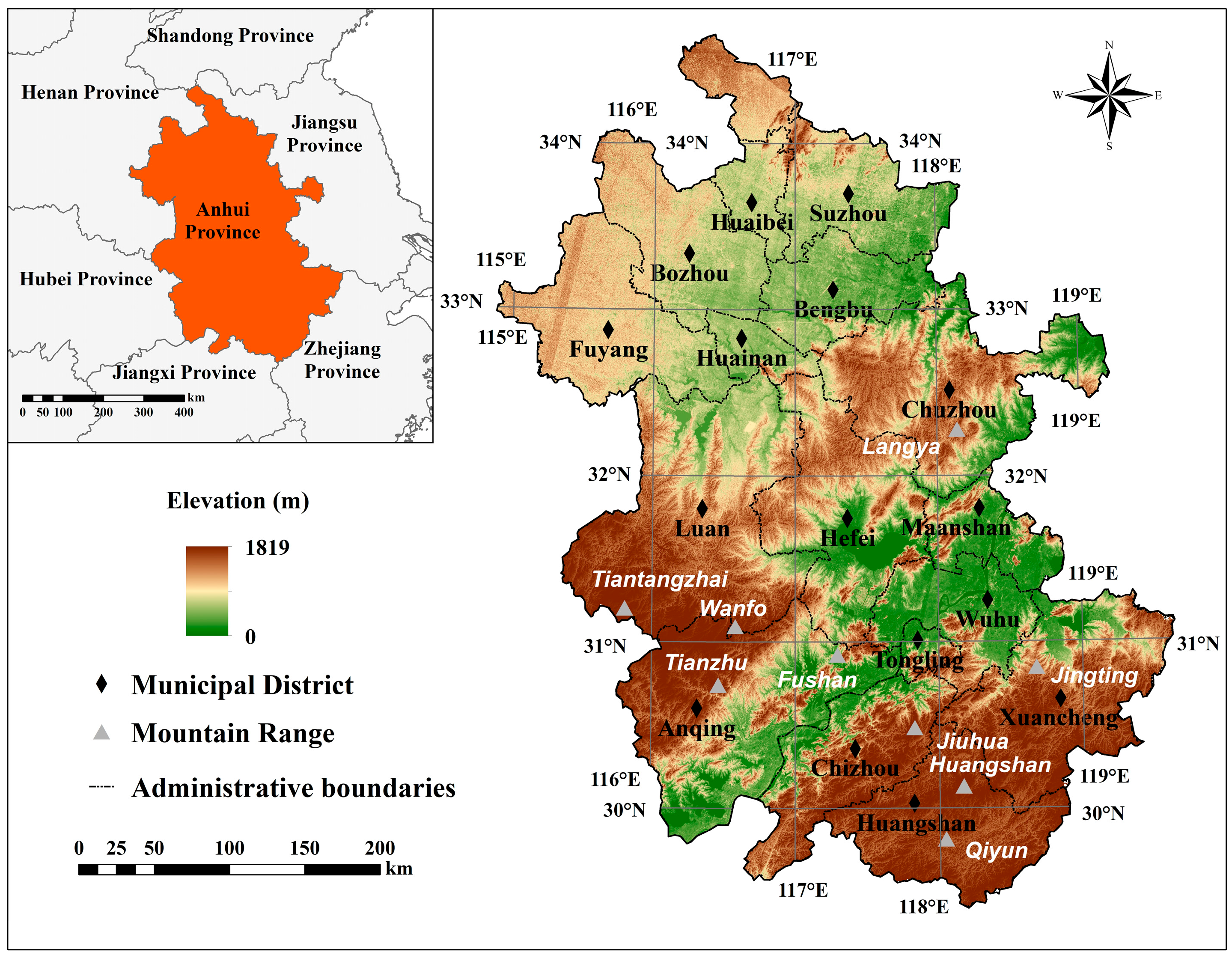
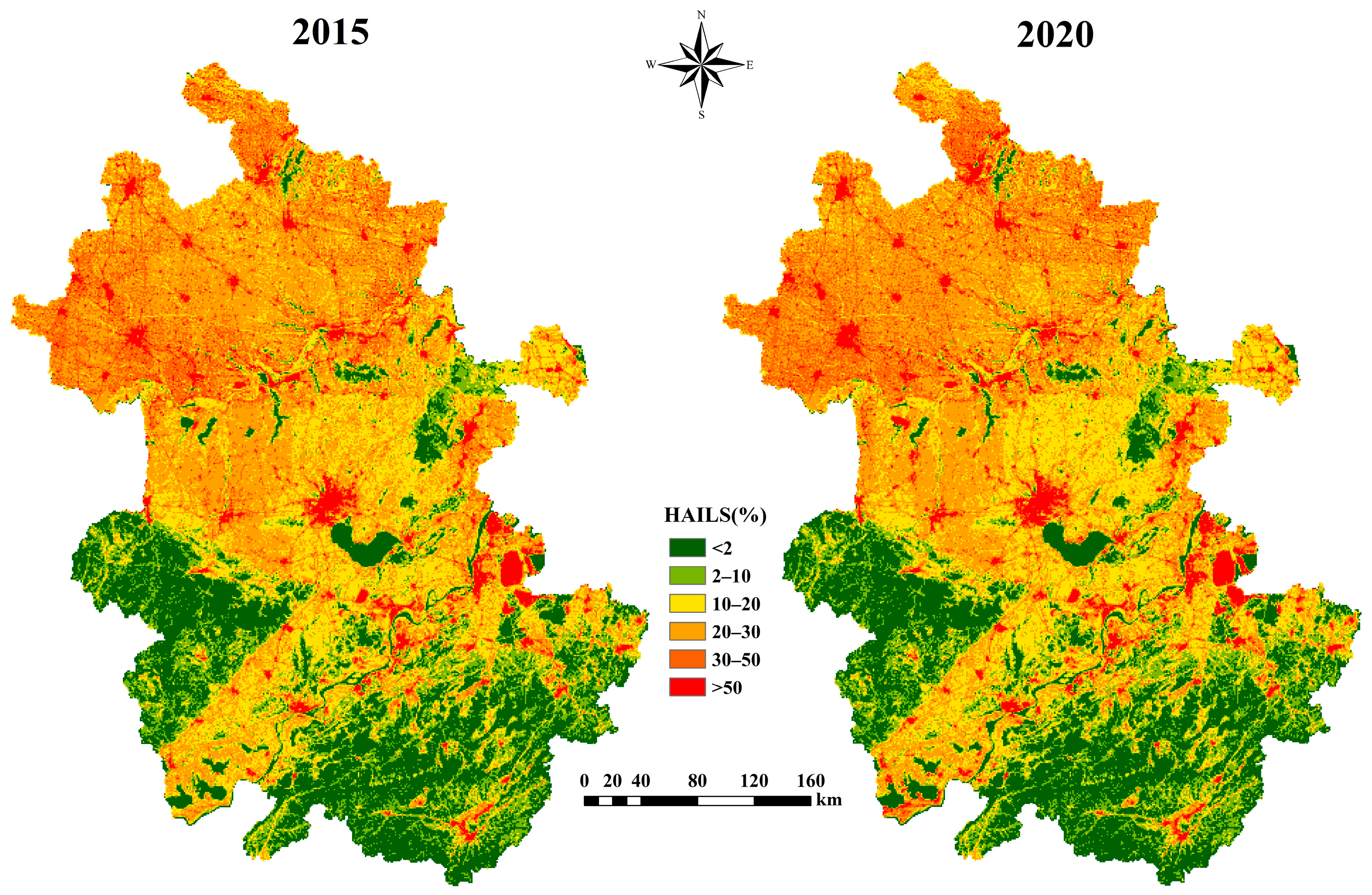
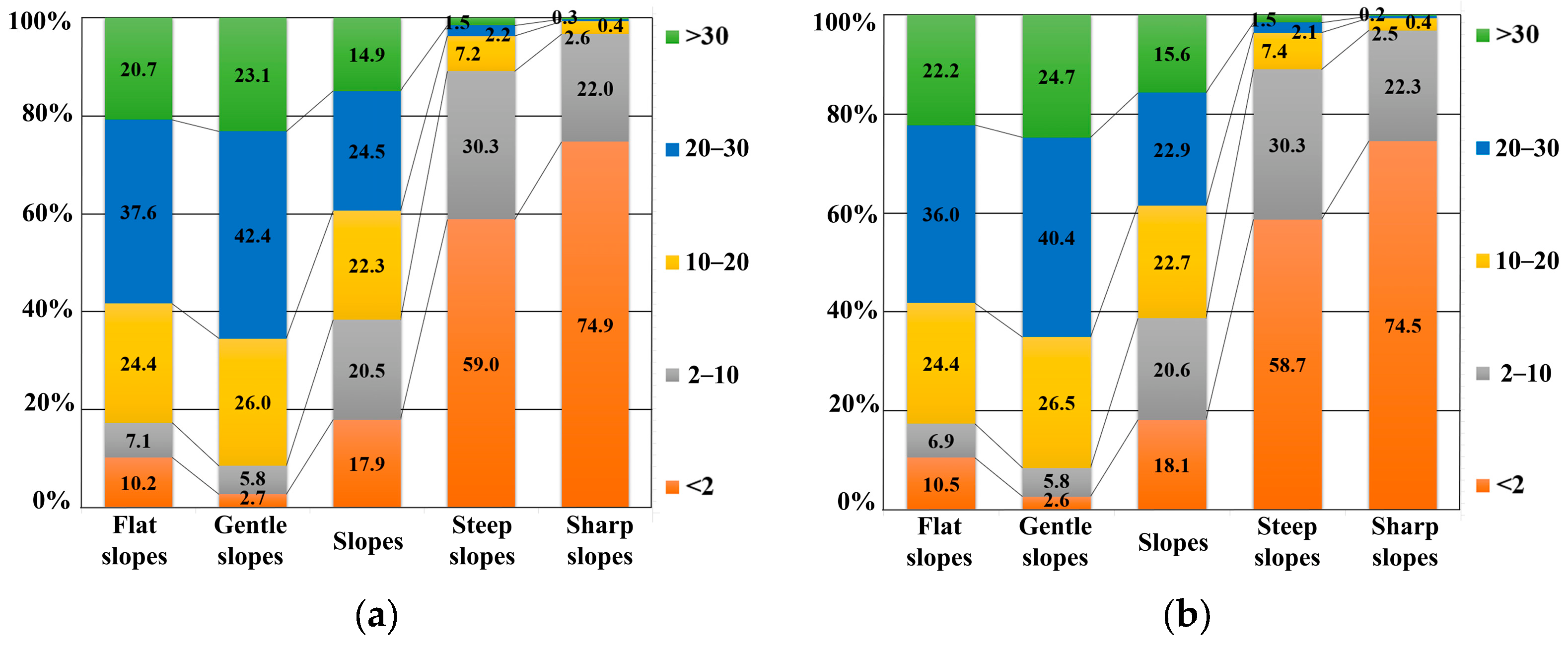
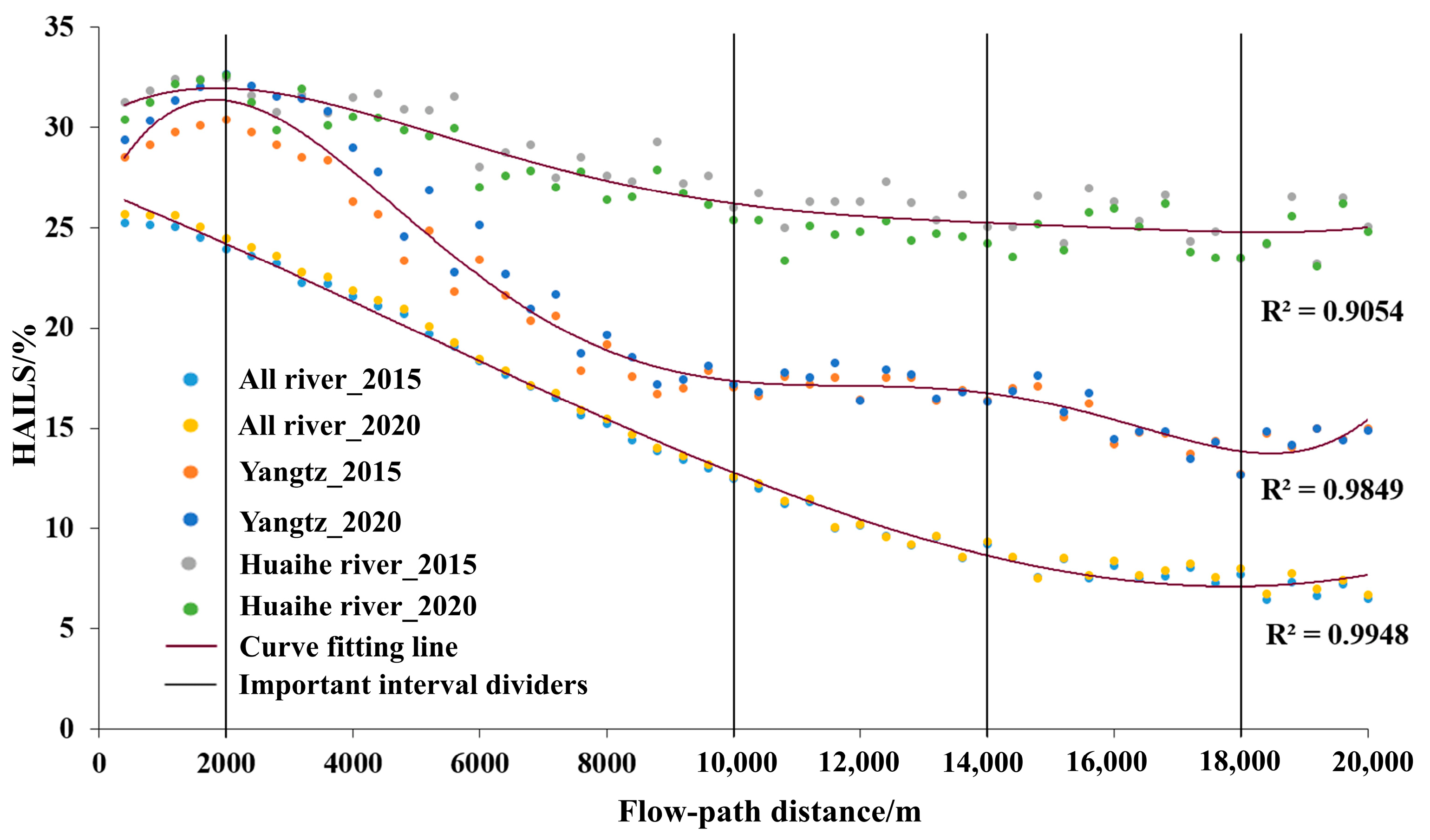
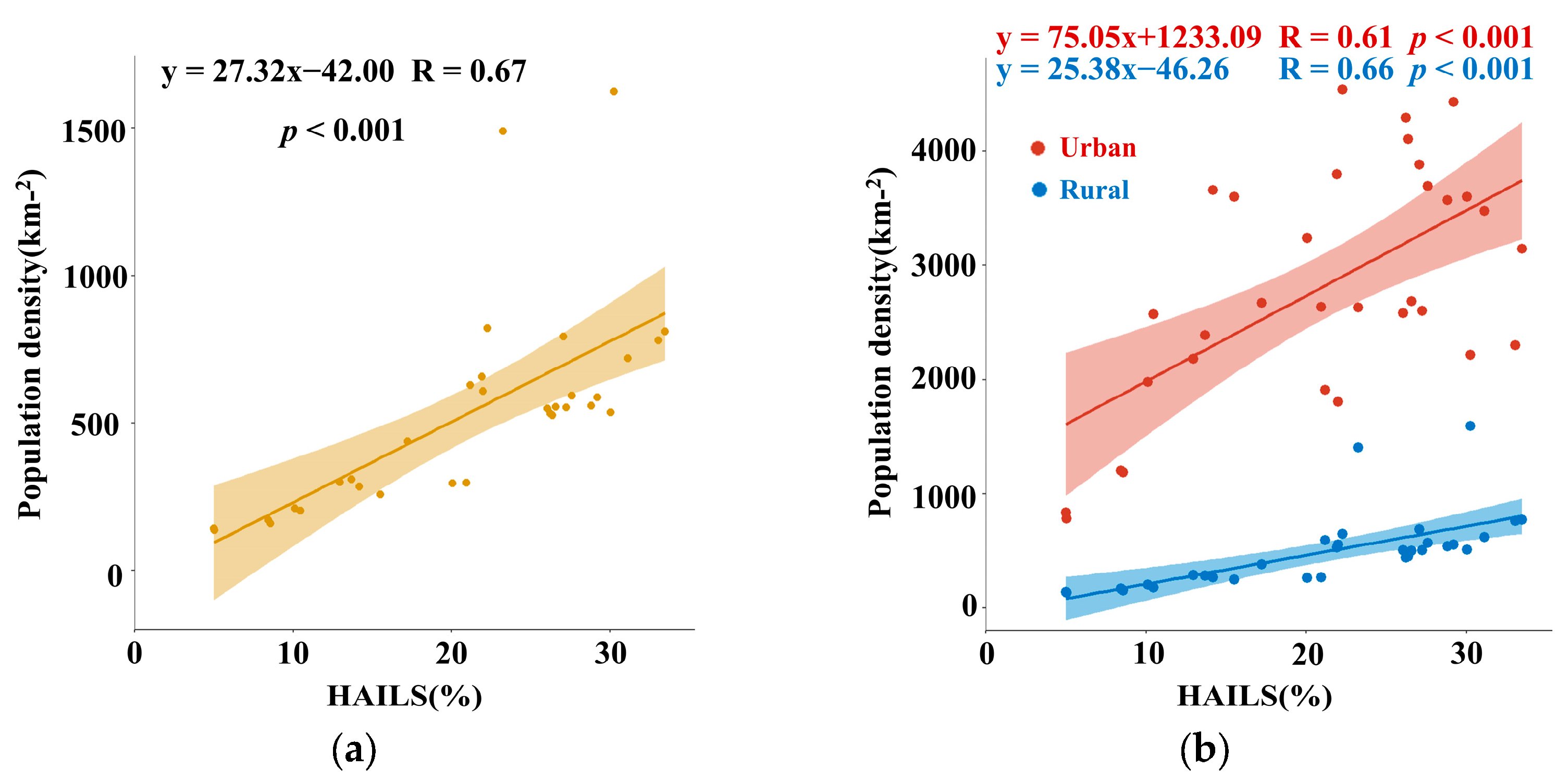
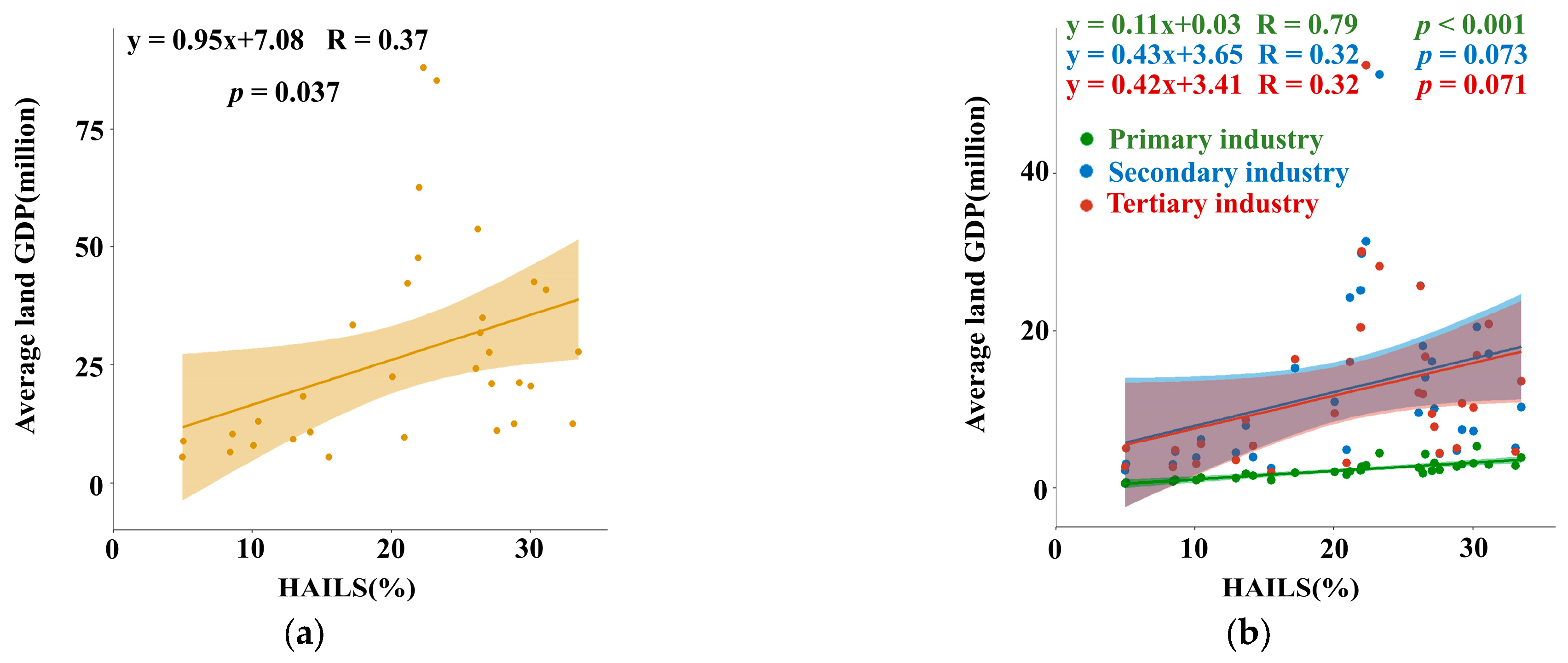

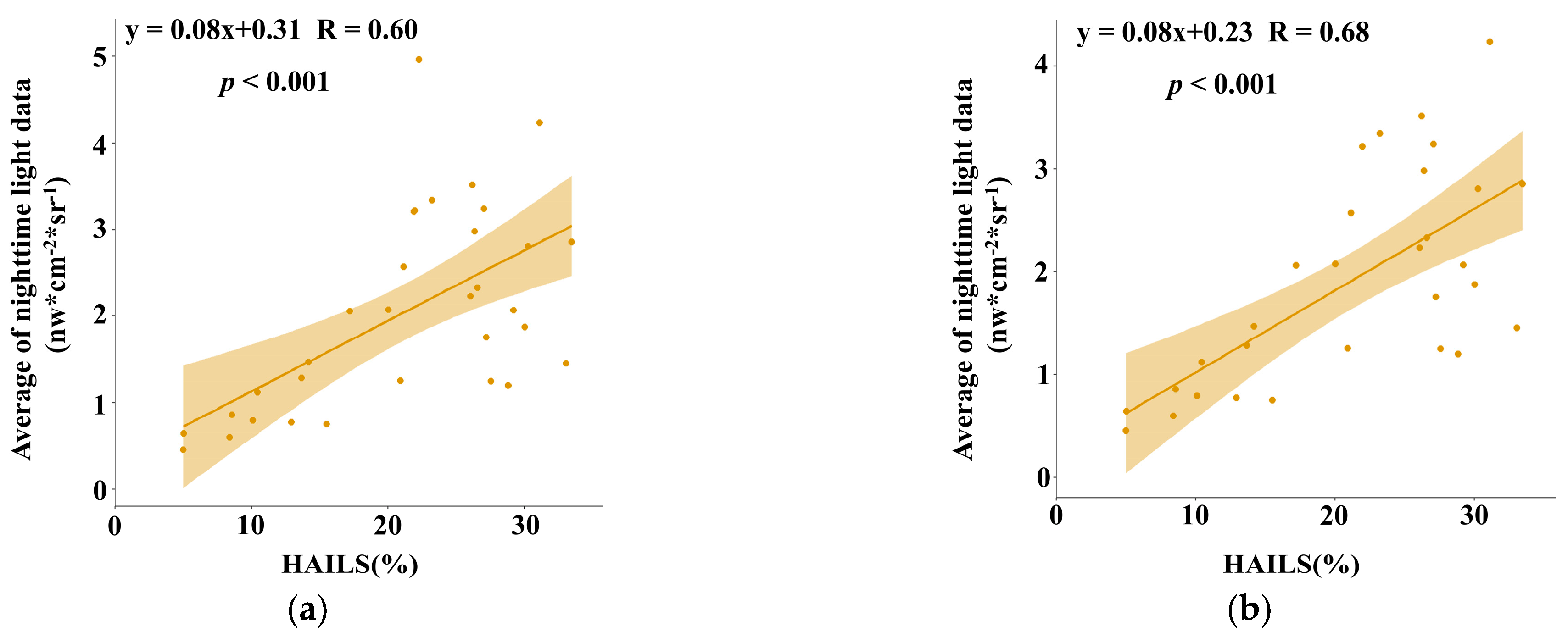
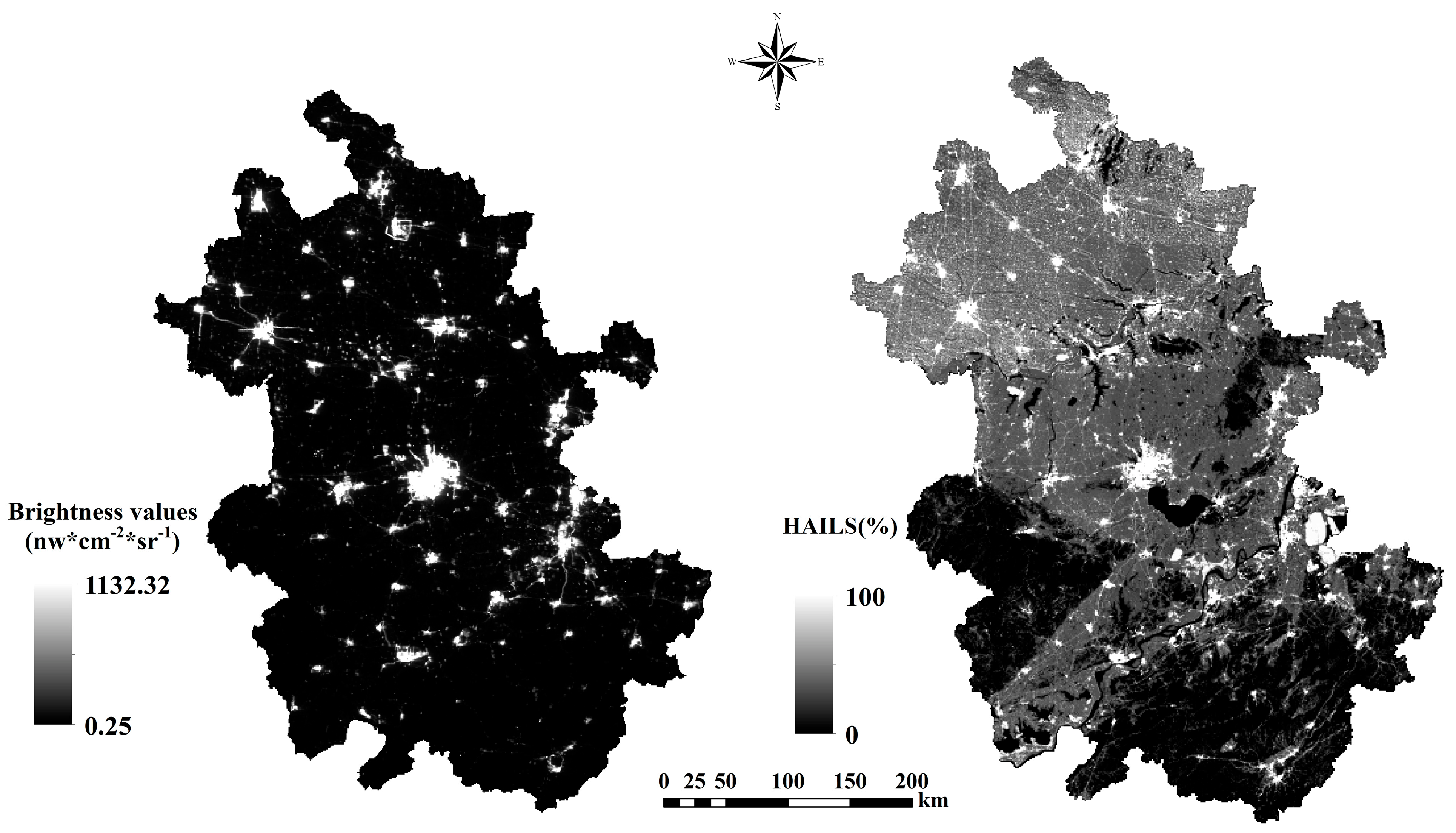
| Primary Classes | Secondary Classes | Description |
|---|---|---|
| Forest lands | Evergreen broadleaf forest; Deciduous broadleaf forest; Evergreen needleleaf forest; Deciduous needleleaf forest; Evergreen broadleaf shrubland; Deciduous broadleaf shrubland; Evergreen needleleaf shrubland; Bamboo; Sparse forest; Sparse shrubland; Burned or logging forest | Natural or seminatural vegetation |
| Grasslands | Temperate meadow steppe; Temperate typical steppe; Temperate desert steppe; Alpine meadow; Alpine steppe; Alpine desert steppe; Thermal tussock; Warm tussock | Natural or seminatural vegetation |
| Wetlands | Forested wetland; Shrub wetland Herbaceous Wetland; Salt marshes | Natural or seminatural vegetation |
| Croplands | Paddy field; Dry farmland; Artificial Tame Pastures; Aquaculture land; Facility agricultural land | Artificial vegetation or artificial land |
| Horticulture lands | Shrub–grass green; Lawn; Wetland green; Woody horticulture land; Vine horticulture land; Herb horticulture land; Aquatic horticulture land; Nursery garden | Artificial vegetation |
| Built-up lands | Settlement; Transportation land; Mining field; Salt ponds; Undeveloped land | Artificial construction land |
| Water | Perennial water; Seasonal water; Beaches | Natural or artificial water |
| Desert | Desert shrubland; Salt desert | Natural land surface |
| Tundra | Permanent ice/snow; Tundra | Natural land surface |
| Barren lands | Bare rock; Gobi; Bare soil; Desert; Sandy land; Cold desert; Salina | Natural land surface |
| HAILS | <2% | 2–10% | 10–20% | 20–30% | >30% | |||||
|---|---|---|---|---|---|---|---|---|---|---|
| Mean (%) | Area (km2) | Mean (%) | Area (km2) | Mean (%) | Area (km2) | Mean (%) | Area (km2) | Mean (%) | Area (km2) | |
| 2015 | 0.4 | 26,428 | 5.4 | 18,151 | 16.7 | 28,565 | 23.7 | 45,034 | 44.1 | 24,155 |
| 2020 | 0.4 | 26,503 | 5.4 | 18,074 | 16.7 | 29,324 | 23.9 | 42,741 | 44.7 | 25,691 |
Disclaimer/Publisher’s Note: The statements, opinions and data contained in all publications are solely those of the individual author(s) and contributor(s) and not of MDPI and/or the editor(s). MDPI and/or the editor(s) disclaim responsibility for any injury to people or property resulting from any ideas, methods, instructions or products referred to in the content. |
© 2023 by the authors. Licensee MDPI, Basel, Switzerland. This article is an open access article distributed under the terms and conditions of the Creative Commons Attribution (CC BY) license (https://creativecommons.org/licenses/by/4.0/).
Share and Cite
Wu, J.; Gao, W.; Zheng, Z.; Zhao, D.; Zeng, Y. Study of Human Activity Intensity from 2015 to 2020 Based on Remote Sensing in Anhui Province, China. Remote Sens. 2023, 15, 2029. https://doi.org/10.3390/rs15082029
Wu J, Gao W, Zheng Z, Zhao D, Zeng Y. Study of Human Activity Intensity from 2015 to 2020 Based on Remote Sensing in Anhui Province, China. Remote Sensing. 2023; 15(8):2029. https://doi.org/10.3390/rs15082029
Chicago/Turabian StyleWu, Jinchen, Wenwen Gao, Zhaoju Zheng, Dan Zhao, and Yuan Zeng. 2023. "Study of Human Activity Intensity from 2015 to 2020 Based on Remote Sensing in Anhui Province, China" Remote Sensing 15, no. 8: 2029. https://doi.org/10.3390/rs15082029
APA StyleWu, J., Gao, W., Zheng, Z., Zhao, D., & Zeng, Y. (2023). Study of Human Activity Intensity from 2015 to 2020 Based on Remote Sensing in Anhui Province, China. Remote Sensing, 15(8), 2029. https://doi.org/10.3390/rs15082029





